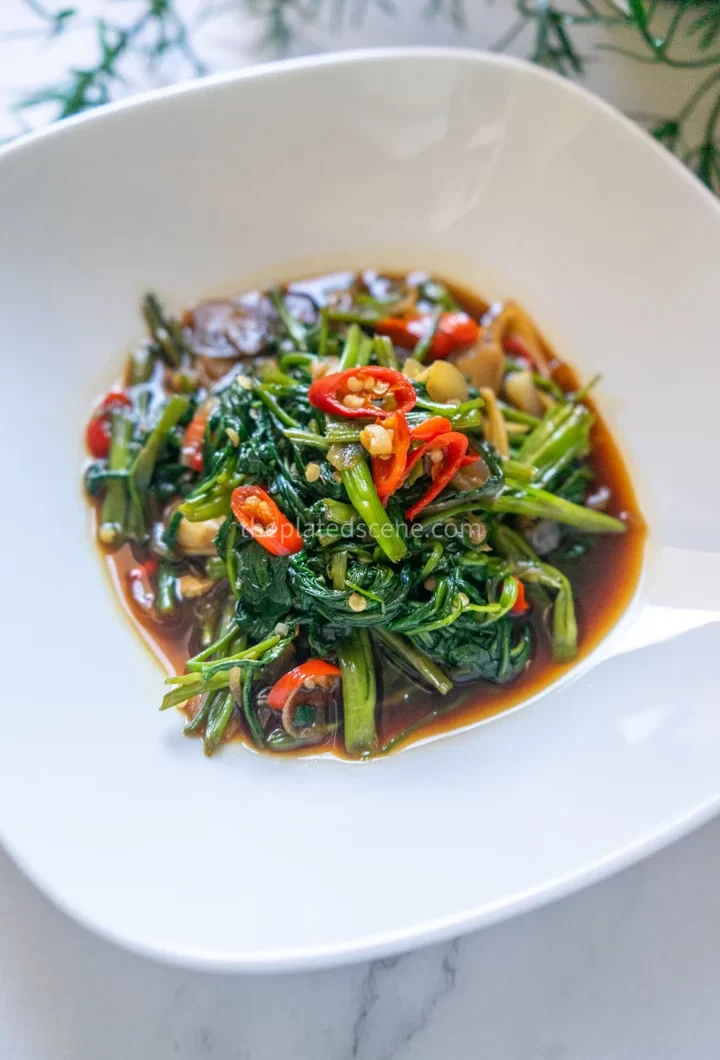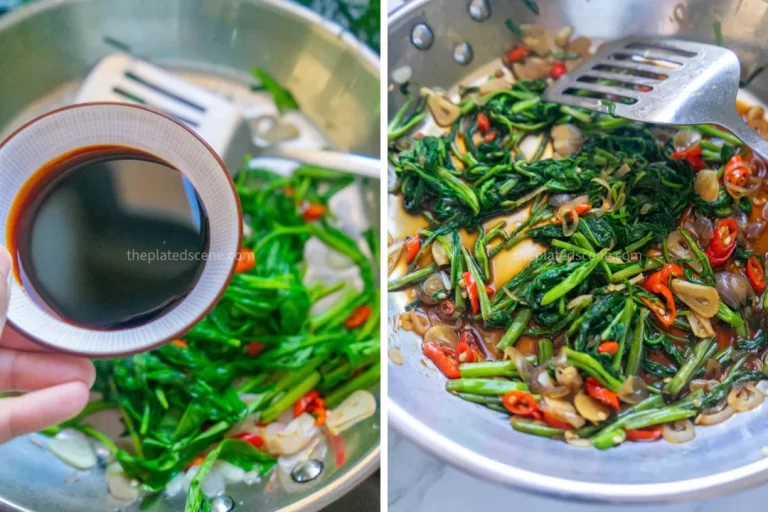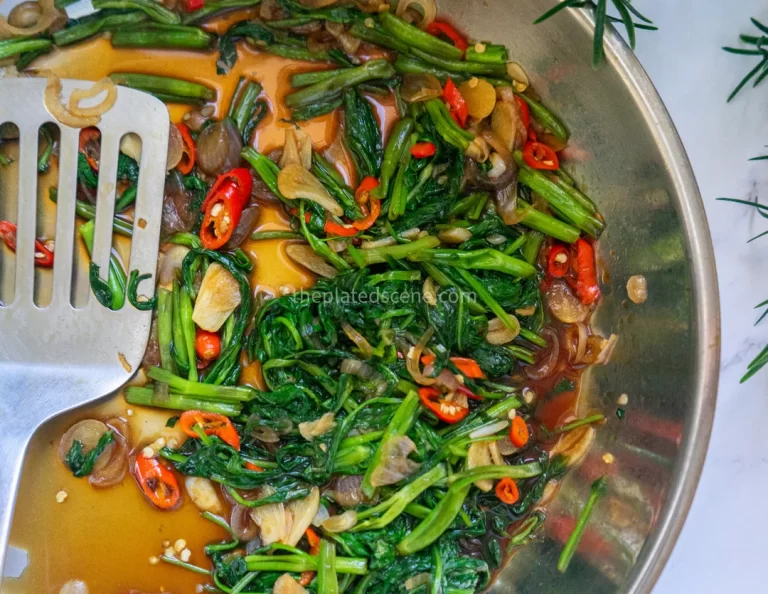It’s 12:30 PM, your inbox is full, and your stomach is growling. On days like this, I turn to a dish that never fails me: tumis kangkung, or kangkung stir fry. It’s quick, comforting, and full of flavor—everything I need during a tight lunch break while working from home.
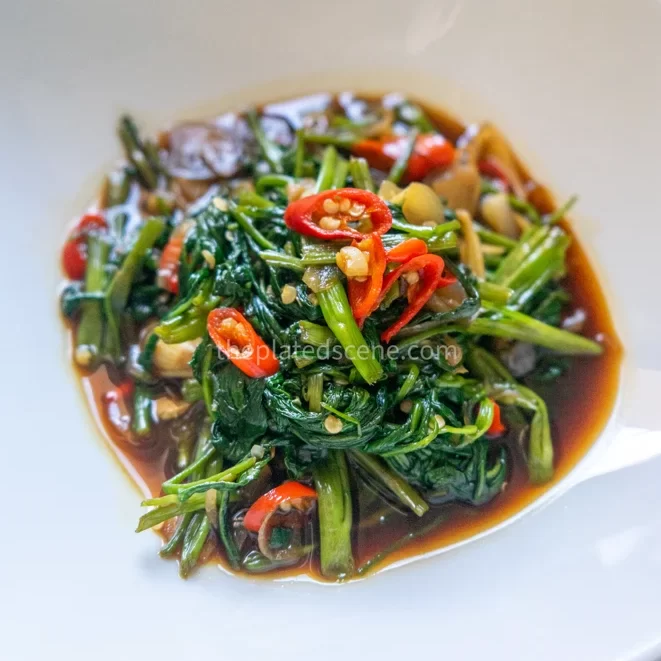
This isn’t just a shortcut meal. Tumis kangkung is one of those everyday dishes that feel like home. With just a few ingredients and a hot pan, I can have a warm, nourishing plate of stir-fried greens ready in minutes. It’s the kind of food that reminds me of my childhood, of busy days balanced with simple pleasures.
In this post, I’ll walk you through what kangkung actually is, where this dish comes from, why some say it makes you sleepy, and how you can make it your own—even if you can’t find kangkung. Whether you’re an Indonesian food lover or just looking for an easy veggie stir fry to add to your meal rotation, this one’s worth bookmarking.
Table of Contents
What Is Kangkung (or Kangkong)?
Before diving into the stir-fry itself, let’s talk about the star ingredient: kangkung, also known as kangkong, water spinach, or morning glory in English. Despite the different names, this leafy green vegetable is the same across Southeast Asia and parts of China. It has long, hollow stems and tender leaves that cook quickly and absorb flavor beautifully.
Kangkung thrives in tropical climates, growing easily in both water and soil, which is why you’ll see it used in dishes across Indonesia, Malaysia, Thailand, Vietnam, and the Philippines. In Indonesia, kangkung is a staple—often sold in large bundles in traditional markets and cooked in countless variations, but tumis kangkung is arguably the most popular preparation.
When stir-fried, kangkung retains a slight crunch from the stems, while the leaves become silky soft. It’s often cooked with garlic, shallots, chili, and a touch of oyster or soy sauce, resulting in a flavorful dish that’s savory, spicy, and just a little sweet.
Want to learn more about this versatile vegetable?
Check out this guide on water spinach (kangkung) here.
Does Kangkung Make You Sleepy?
A popular belief in Indonesia is that eating kangkung can make you sleepy. Many people say that it has a naturally calming effect on the body. This claim has even made it into jokes and memes—implying that kangkung should be avoided before doing anything that requires alertness.
But is it true?
While there’s no conclusive scientific evidence directly linking kangkung to drowsiness, the myth likely stems from kangkung’s high magnesium and potassium content. These minerals are known to support muscle relaxation and calm the nervous system, which might explain why some people feel a little more relaxed after eating it. In traditional medicine, kangkung is sometimes used to treat insomnia or anxiety.
That said, I’ve personally never felt sleepy after eating tumis kangkung for lunch. If anything, it gives me a small mood boost. So unless you’re particularly sensitive, feel free to enjoy it any time of day!
The History Behind Tumis Kangkung
Tumis kangkung is a dish that perfectly represents the simplicity and balance of Indonesian home cooking. The word tumis means to sauté or stir-fry in Indonesian, and it refers to a cooking method that typically involves frying aromatics like garlic, shallot, and chili before adding vegetables or protein.
Kangkung became a common household ingredient in Indonesia due to its affordability, quick growth, and versatility. Historically, it was often grown in home gardens or even picked wild near waterways. Stir-frying kangkung likely emerged as a way to make a quick yet satisfying meal using minimal resources.
Though tumis kangkung doesn’t have a grand origin story, its roots lie deep in everyday life. It’s the kind of dish that reminds many Indonesians of family dinners, budget-friendly meals during student days, or simple street food served with sambal and rice.
Over time, tumis kangkung also traveled across borders. Similar versions exist in Thai (pad pak boong fai daeng) and Malaysian cuisines, and even Chinese restaurants offer stir-fried water spinach with garlic. But the Indonesian version has its own identity—especially when sambal or terasi (shrimp paste) is added into the mix.
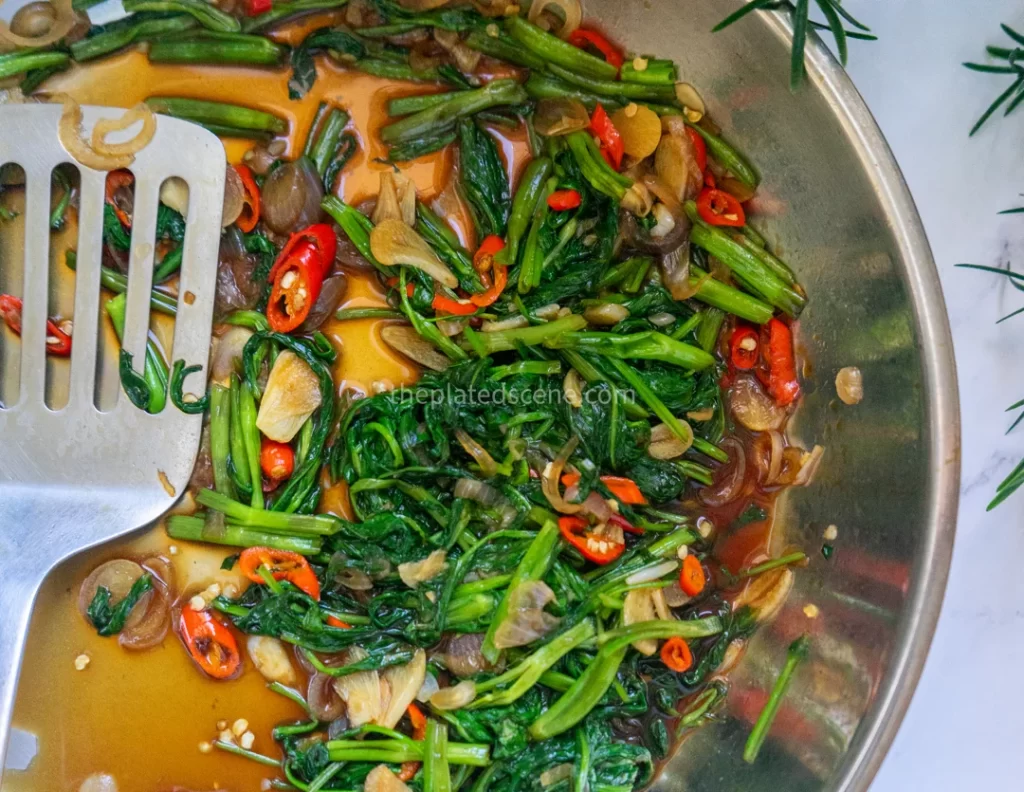
What Does Tumis Kangkung Taste Like?
The flavor profile of tumis kangkung is bold, earthy, and incredibly satisfying. The garlic and shallots create a fragrant base, while the chilies bring heat. When seasoned with oyster sauce or kecap manis (sweet soy sauce), it takes on a rich umami flavor with subtle sweetness.
The kangkung itself has a clean, grassy taste with a soft crunch from the stems. It absorbs the stir-fry sauce quickly, so every bite bursts with flavor. When made right, tumis kangkung has a perfect balance of spicy, savory, and fresh.
You can also adjust the spiciness level to your liking. Personally, I like to add one or two bird’s eye chilies to give it a kick, especially if I’m pairing it with plain steamed rice.
Variations: What If You Don’t Have Kangkung?
While tumis kangkung specifically refers to stir-fried kangkung, you can easily apply the same technique and flavor base to other vegetables if kangkung isn’t available.
Here are some great substitutes:
- Spinach: While softer and less crunchy, it cooks quickly and absorbs flavor well.
- Choy sum: A fantastic alternative with slightly bitter notes and crunchy stalks.
- Sweet potato leaves: These are commonly used in Filipino cuisine and work wonderfully in stir-fries.
- Chinese watercress: Slightly peppery and holds its shape when cooked.
- Green beans: Just blanch first to reduce cooking time before stir-frying.
If you want to make a heartier version, you can also add:
- Tofu (fried or firm)
- Tempeh slices
- Shrimp or anchovies
- Sliced mushrooms (like oyster or shiitake)
While none of these substitutes can fully replicate the unique texture of kangkung, they’ll still result in a delicious dish.
Things to Watch Out For When Making Tumis Kangkung
Although tumis kangkung is easy to make, there are a few tips that can help you avoid common pitfalls:
- Prep Ahead: Kangkung cooks really fast, so make sure all your ingredients—garlic, shallots, chilies, sauces—are prepped and ready to go before turning on the stove.
- Don’t Overcook: The key to a good kangkung stir fry is to retain some crunch in the stems. Overcooking will result in soggy, limp vegetables. A quick stir-fry over high heat is ideal.
- Wash Thoroughly: Kangkung often grows near water and can carry a bit of dirt or sand. Soak it in water and rinse it well several times to avoid unpleasant grit.
- Use High Heat: Stir-frying is all about quick cooking over high heat. This helps lock in flavor and gives the dish that signature “wok hei” or wok aroma.
- Be Mindful with Salt: If you’re using oyster sauce or shrimp paste, go easy on the salt—these ingredients are already salty.
- Serve Immediately: Tumis kangkung is best enjoyed fresh and hot. It doesn’t hold well, so try to cook it right before serving.
Tumis kangkung might be humble, but it truly deserves a spot in your regular cooking routine. It’s quick, nutritious, adaptable, and packed with flavor. Whether you’re a seasoned home cook or someone just starting out in the kitchen, this dish offers a low-effort, high-reward experience that brings a little taste of Indonesia into your home.
And if you’re like me—juggling Zoom calls, emails, and a grumbling stomach—tumis kangkung just might be the lunch break miracle you’ve been looking for.
Nutrition Guide for Tumis Kangkung
Serving Size: 1 | Based on 220g kangkung stir-fried with garlic, chili, shallots, and seasonings
Estimated Macronutrients
| Nutrient | Amount (approx.) |
|---|---|
| Calories | 110–130 kcal |
| Protein | 3–4 g |
| Carbohydrates | 18–20 g |
| Fat | 2–3 g |
| Fiber | 3–5 g |
Note: Calories come mostly from kecap manis (sweet soy sauce), garlic, shallots, and oil if added. If you stir-fry using oil, add ~40–50 kcal per tsp.
Micronutrient Highlights (from kangkung and aromatics)
- Vitamin A: Supports eye health (kangkung is rich in beta-carotene)
- Vitamin C: Boosts immunity (found in kangkung, shallots, and chili)
- Iron: Helps prevent fatigue (moderate levels in kangkung)
- Calcium: Promotes bone strength (kangkung)
- Magnesium: Aids in muscle relaxation and stress relief
- Potassium: Helps regulate blood pressure
- Folate: Supports cell growth and function
Health Notes
- Low in calories and high in fiber, making it great for light meals or weight management.
- The combination of garlic and chili provides anti-inflammatory and metabolism-boosting effects.
- Kecap manis adds sweetness and depth, but keep an eye on the sugar content if you’re watching your intake.
Ingredients for Tumis Kangkung
To make a flavorful plate of tumis kangkung, you only need a handful of simple ingredients that come together beautifully. Here’s what goes into this quick and easy kangkung stir fry, along with helpful tips in case you need to substitute:
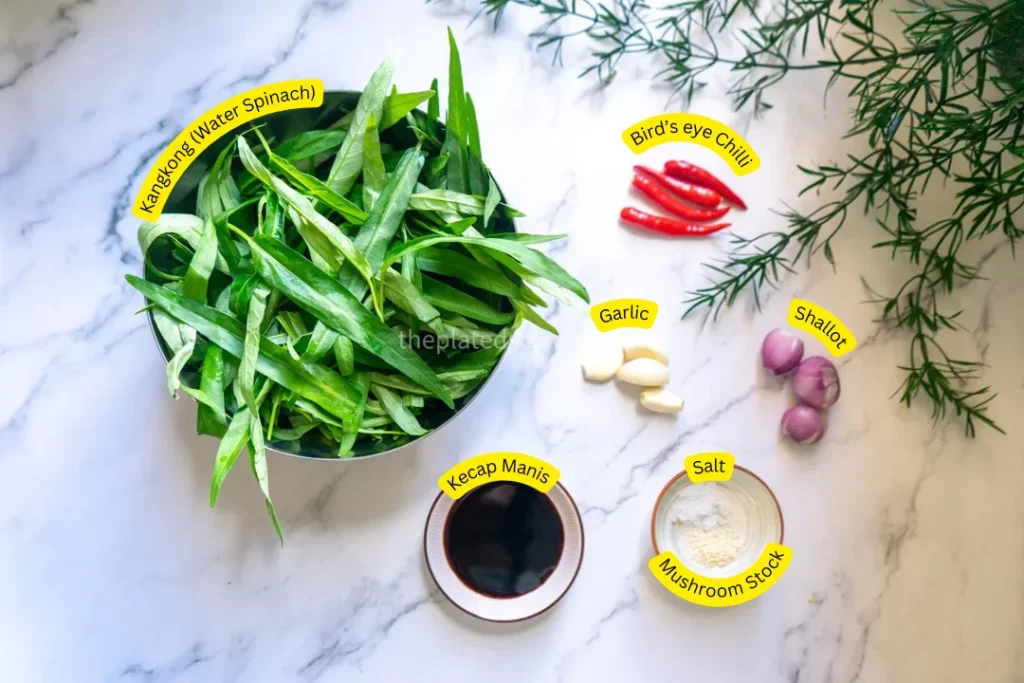
- Kangkung (water spinach or morning glory)
This leafy green is the star of the dish. It has hollow stems that stay crisp and tender leaves that wilt perfectly in the pan. If you can’t find kangkung, you can substitute with choy sum, spinach, sweet potato leaves, or even young kale—just adjust the cooking time slightly, as softer greens cook faster. - Garlic
Garlic is essential in tumis kangkung. It builds the aromatic base and gives the dish its signature savory depth. Feel free to use more if you love a strong garlic flavor. If you’re out of fresh garlic, garlic powder can work in a pinch, though the flavor won’t be quite the same. - Shallots
Shallots add sweetness and balance to the stir fry. You can substitute with red onion or even yellow onion if needed, but shallots offer a more delicate, subtly sweet note that’s ideal for this dish. - Bird’s eye chili
These small but fiery chilies bring heat and a burst of flavor. You can adjust the amount based on your spice preference. If you prefer a milder version, use large red chili (for color with less heat), or omit entirely. - Water
A splash of water helps wilt the kangkung quickly and distribute the flavors evenly. If you’d like a slightly richer flavor, you can replace the water with light vegetable broth. - Salt
Salt enhances the overall flavor. If you’re using salty sauces or stock, taste before adding more to avoid over-seasoning. - Mushroom stock powder
This adds an umami-rich, savory kick that deepens the flavor without overpowering the vegetables. If unavailable, you can use vegetable bouillon, soy sauce, or a pinch of MSG as an alternative. - Kecap manis (sweet soy sauce)
Kecap manis gives tumis kangkung its signature sweet-salty finish. It also adds a glossy coating to the vegetables. If you don’t have it on hand, mix regular soy sauce with a bit of palm sugar or brown sugar to mimic the flavor.
Frequently Asked Questions (FAQ)
Can I make tumis kangkung without chili?
Yes! Simply skip the bird’s eye chilies for a milder version that still tastes great thanks to the garlic and kecap manis.
Is this dish vegan?
Yes, if you use mushroom stock and make sure your kecap manis is vegan-friendly.
Can I prepare this ahead of time?
It’s best eaten fresh, but you can prep the ingredients in advance and stir fry just before serving.
Is it okay to stir-fry without oil?
Yes, you can use a splash of water or low-sodium vegetable broth instead of oil, though the flavor and texture will be slightly different.
🍽 What to Serve with Tumis Kangkung
Tumis kangkung is rarely served on its own. It’s usually part of a complete meal, adding a burst of greens and flavor to balance out richer dishes. Whether you’re enjoying a casual lunch or building a classic Indonesian spread, here are some delicious pairings to serve alongside your kangkung stir fry:
- Steamed rice
Simple, fluffy white rice is the best companion. It soaks up all the garlicky, sweet-savory sauce and balances out the spice from the chilies. - Fried tempeh or tofu
For a protein boost, pair your stir-fried kangkung with crispy tempeh or golden-brown tofu. You can serve them plain, or go with tahu tempe bacem for a sweet and aromatic twist. - Ayam goreng lengkuas
Fried chicken with galangal seasoning brings texture and flavor that pairs beautifully with the lightness of tumis kangkung. This is a classic warung-style combination. - Telur balado
Spicy red chili-coated eggs are a great side—rich, punchy, and satisfying next to the fresh, earthy greens. - Sambal and krupuk
Don’t forget the extras! A spoonful of sambal and some crunchy crackers make the whole meal feel more complete.
These combinations turn tumis kangkung from a simple stir-fry into a well-rounded, comforting Indonesian meal.


